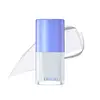What's inside
What's inside
 Key Ingredients
Key Ingredients

 Benefits
Benefits

 Concerns
Concerns

 Ingredients Side-by-side
Ingredients Side-by-side

Water
Skin ConditioningGlycerin
HumectantMethyl Trimethicone
Skin ConditioningOctyldodecyl Stearoyl Stearate
EmollientPentaerythrityl Stearate/Caprate/Caprylate/Adipate
EmollientCI 77891
Cosmetic ColorantHydrogenated Polydecene
EmollientPentylene Glycol
Skin Conditioning1,2-Hexanediol
Skin ConditioningHydrogenated Olive Oil
Skin ConditioningOlea Europaea Fruit Oil
MaskingOlea Europaea Oil Unsaponifiables
Skin ConditioningOpuntia Coccinellifera Fruit Extract
Skin ConditioningSodium Hyaluronate
HumectantChitosan
Hydrolyzed Hyaluronic Acid
HumectantHyaluronic Acid
HumectantPolymethylsilsesquioxane
Trimethylsiloxysilicate
EmollientAmmonium Acryloyldimethyltaurate/Vp Copolymer
Betaine
HumectantBisabolol
MaskingIsododecane
EmollientPotassium Cetyl Phosphate
EmulsifyingHydroxyethyl Acrylate/Sodium Acryloyldimethyl Taurate Copolymer
Emulsion StabilisingSilica
AbrasiveSorbitan Sesquioleate
EmulsifyingPanthenol
Skin ConditioningGlyceryl Caprylate
EmollientC12-20 Alkyl Glucoside
EmulsifyingAluminum Hydroxide
EmollientSodium Acrylate/Sodium Acryloyldimethyl Taurate Copolymer
Emulsion StabilisingPolyisobutene
Triethoxycaprylylsilane
Adenosine
Skin ConditioningTrisodium Ethylenediamine Disuccinate
Caprylyl/Capryl Glucoside
CleansingSorbitan Oleate
EmulsifyingBeta-Glucan
Skin ConditioningButylene Glycol
HumectantDipropylene Glycol
HumectantPropanediol
SolventHydrogenated Lecithin
EmulsifyingCholesterol
EmollientBenzyl Glycol
SolventHydrolyzed Glycosaminoglycans
HumectantCeramide NP
Skin ConditioningHydroxypropyltrimonium Hyaluronate
Sodium Hyaluronate Crosspolymer
HumectantEthylhexylglycerin
Skin ConditioningSodium Acetylated Hyaluronate
HumectantHydrolyzed Sodium Hyaluronate
Skin ConditioningPotassium Hyaluronate
Skin ConditioningC14-22 Alcohols
Emulsion StabilisingCetearyl Alcohol
EmollientParfum
MaskingAlpha-Isomethyl Ionone
PerfumingLinalool
PerfumingWater, Glycerin, Methyl Trimethicone, Octyldodecyl Stearoyl Stearate, Pentaerythrityl Stearate/Caprate/Caprylate/Adipate, CI 77891, Hydrogenated Polydecene, Pentylene Glycol, 1,2-Hexanediol, Hydrogenated Olive Oil, Olea Europaea Fruit Oil, Olea Europaea Oil Unsaponifiables, Opuntia Coccinellifera Fruit Extract, Sodium Hyaluronate, Chitosan, Hydrolyzed Hyaluronic Acid, Hyaluronic Acid, Polymethylsilsesquioxane, Trimethylsiloxysilicate, Ammonium Acryloyldimethyltaurate/Vp Copolymer, Betaine, Bisabolol, Isododecane, Potassium Cetyl Phosphate, Hydroxyethyl Acrylate/Sodium Acryloyldimethyl Taurate Copolymer, Silica, Sorbitan Sesquioleate, Panthenol, Glyceryl Caprylate, C12-20 Alkyl Glucoside, Aluminum Hydroxide, Sodium Acrylate/Sodium Acryloyldimethyl Taurate Copolymer, Polyisobutene, Triethoxycaprylylsilane, Adenosine, Trisodium Ethylenediamine Disuccinate, Caprylyl/Capryl Glucoside, Sorbitan Oleate, Beta-Glucan, Butylene Glycol, Dipropylene Glycol, Propanediol, Hydrogenated Lecithin, Cholesterol, Benzyl Glycol, Hydrolyzed Glycosaminoglycans, Ceramide NP, Hydroxypropyltrimonium Hyaluronate, Sodium Hyaluronate Crosspolymer, Ethylhexylglycerin, Sodium Acetylated Hyaluronate, Hydrolyzed Sodium Hyaluronate, Potassium Hyaluronate, C14-22 Alcohols, Cetearyl Alcohol, Parfum, Alpha-Isomethyl Ionone, Linalool
Prunus Serrulata Flower Extract
Skin ConditioningButylene Glycol
HumectantCyclopentasiloxane
EmollientCyclohexasiloxane
EmollientTitanium Dioxide
Cosmetic ColorantNiacinamide
SmoothingCetyl PEG/PPG-10/1 Dimethicone
EmulsifyingGlycerin
HumectantSodium Chloride
MaskingDimethicone
EmollientDimethicone/Vinyl Dimethicone Crosspolymer
Skin ConditioningAloe Barbadensis Leaf Extract
EmollientAluminum Hydroxide
EmollientTriethoxycaprylylsilane
Polyglutamic Acid
Skin ConditioningCitrus Limon Peel Oil
MaskingCitrus Grandis Peel Oil
MaskingRosmarinus Officinalis Leaf Oil
MaskingLavandula Angustifolia Oil
MaskingPelargonium Graveolens Flower Oil
MaskingDisodium EDTA
Tocopheryl Acetate
AntioxidantZanthoxylum Piperitum Fruit Extract
Skin ConditioningUsnea Barbata Extract
Pulsatilla Koreana Extract
Skin ConditioningPrunus Serrulata Flower Extract, Butylene Glycol, Cyclopentasiloxane, Cyclohexasiloxane, Titanium Dioxide, Niacinamide, Cetyl PEG/PPG-10/1 Dimethicone, Glycerin, Sodium Chloride, Dimethicone, Dimethicone/Vinyl Dimethicone Crosspolymer, Aloe Barbadensis Leaf Extract, Aluminum Hydroxide, Triethoxycaprylylsilane, Polyglutamic Acid, Citrus Limon Peel Oil, Citrus Grandis Peel Oil, Rosmarinus Officinalis Leaf Oil, Lavandula Angustifolia Oil, Pelargonium Graveolens Flower Oil, Disodium EDTA, Tocopheryl Acetate, Zanthoxylum Piperitum Fruit Extract, Usnea Barbata Extract, Pulsatilla Koreana Extract
 Reviews
Reviews

Ingredients Explained
These ingredients are found in both products.
Ingredients higher up in an ingredient list are typically present in a larger amount.
Aluminum Hydroxide is a form of aluminum. It can be naturally found in nature as the mineral gibbsite. In cosmetics, Aluminum Hydroxide is used as a colorant, pH adjuster, and absorbent.
As a colorant, Aluminum Hydroxide may add opacity, or reduce the transparency. Aluminum hydroxide is contains both basic and acidic properties.
According to manufacturers, this ingredient is an emollient and humectant. This means it helps hydrate the skin.
In medicine, this ingredient is used to help relieve heartburn and help heal ulcers.
There is currently no credible scientific evidence linking aluminum hydroxide in cosmetics to increased cancer risk.
Major health organizations allow the use of aluminum hydroxide in personal care products and have not flagged it as a carcinogenic risk at typical usage levels.
Learn more about Aluminum HydroxideButylene Glycol (or BG) is used within cosmetic products for a few different reasons:
Overall, Butylene Glycol is a safe and well-rounded ingredient that works well with other ingredients.
Though this ingredient works well with most skin types, some people with sensitive skin may experience a reaction such as allergic rashes, closed comedones, or itchiness.
Learn more about Butylene GlycolGlycerin is already naturally found in your skin. It helps moisturize and protect your skin.
A study from 2016 found glycerin to be more effective as a humectant than AHAs and hyaluronic acid.
As a humectant, it helps the skin stay hydrated by pulling moisture to your skin. The low molecular weight of glycerin allows it to pull moisture into the deeper layers of your skin.
Hydrated skin improves your skin barrier; Your skin barrier helps protect against irritants and bacteria.
Glycerin has also been found to have antimicrobial and antiviral properties. Due to these properties, glycerin is often used in wound and burn treatments.
In cosmetics, glycerin is usually derived from plants such as soybean or palm. However, it can also be sourced from animals, such as tallow or animal fat.
This ingredient is organic, colorless, odorless, and non-toxic.
Glycerin is the name for this ingredient in American English. British English uses Glycerol/Glycerine.
Learn more about GlycerinTriethoxycaprylylsilane is a silicone used to bind and stabilize ingredients.
As an emulsifier, it helps prevent ingredients from separating. This can help elongate the shelf life of products.
Triethoxycaprylylsilane is often used to coat mineral sunscreens ingredients to help give a better feel. It also helps reduce oxidative stress in sunscreens.
Learn more about Triethoxycaprylylsilane